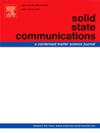A single electrode comparison of Ni & Cu MOF for supercapacitor applications
IF 2.4
4区 物理与天体物理
Q3 PHYSICS, CONDENSED MATTER
引用次数: 0
Abstract
Metal-organic framework (MOF)-based materials can be effectively utilized as supercapacitor electrodes owing to its strong redox activity and large specific surface. This paper presented a detailed comparative analysis of the facile hydrothermally produced nickel and copper MOFs. The advantage of nickel and copper MOFs over other MOFs for energy storage applications is also explored. The comparison explained the high surface area and tunable porosity, exceptional electrical conductivity and electrochemical performance, variable framework, and cost effectiveness of the MOFs. The structural analysis is performed by using X-ray diffraction (XRD), whereas the morphology of the MOFs is observed with scanning electron microscopy (SEM). The electrochemical behavior of MOFs probed by Cyclic Voltammetry (CV), Galvanostatic Charge–Discharge (GCD) and Electrochemical Impedance Spectroscopy (EIS). The electrochemical testing for CV was executed in the range 10–100 mV/s. The nickel MOF electrode produced a specific capacitance of 411.11 F/g at 1 A/g current density. However, the copper MOF electrode formed a specific capacitance of 348.6 F/g. Moreover, nickel MOF exhibited hybrid supercapacitor properties and copper MOF showed pseudo supercapacitor properties revealed by the b-values.
用于超级电容器的Ni和Cu MOF的单电极比较
金属有机骨架(MOF)基材料具有很强的氧化还原活性和较大的比表面积,可以有效地用作超级电容器电极。本文对水热制备的镍和铜mof进行了详细的对比分析。本文还探讨了镍和铜mof相对于其他mof在储能应用中的优势。这一对比解释了mof的高表面积和可调孔隙率、卓越的导电性和电化学性能、可变框架和成本效益。利用x射线衍射(XRD)进行了结构分析,并用扫描电子显微镜(SEM)观察了mof的形貌。利用循环伏安法(CV)、恒流充放电法(GCD)和电化学阻抗谱法(EIS)研究了mof的电化学行为。CV的电化学测试在10 ~ 100 mV/s范围内进行。在电流密度为1 a /g时,镍MOF电极的比电容为411.11 F/g。而铜MOF电极形成的比电容为348.6 F/g。此外,镍MOF表现出混合超级电容器的性质,铜MOF表现出伪超级电容器的性质。
本文章由计算机程序翻译,如有差异,请以英文原文为准。
求助全文
约1分钟内获得全文
求助全文
来源期刊

Solid State Communications
物理-物理:凝聚态物理
CiteScore
3.40
自引率
4.80%
发文量
287
审稿时长
51 days
期刊介绍:
Solid State Communications is an international medium for the publication of short communications and original research articles on significant developments in condensed matter science, giving scientists immediate access to important, recently completed work. The journal publishes original experimental and theoretical research on the physical and chemical properties of solids and other condensed systems and also on their preparation. The submission of manuscripts reporting research on the basic physics of materials science and devices, as well as of state-of-the-art microstructures and nanostructures, is encouraged.
A coherent quantitative treatment emphasizing new physics is expected rather than a simple accumulation of experimental data. Consistent with these aims, the short communications should be kept concise and short, usually not longer than six printed pages. The number of figures and tables should also be kept to a minimum. Solid State Communications now also welcomes original research articles without length restrictions.
The Fast-Track section of Solid State Communications is the venue for very rapid publication of short communications on significant developments in condensed matter science. The goal is to offer the broad condensed matter community quick and immediate access to publish recently completed papers in research areas that are rapidly evolving and in which there are developments with great potential impact.
 求助内容:
求助内容: 应助结果提醒方式:
应助结果提醒方式:


